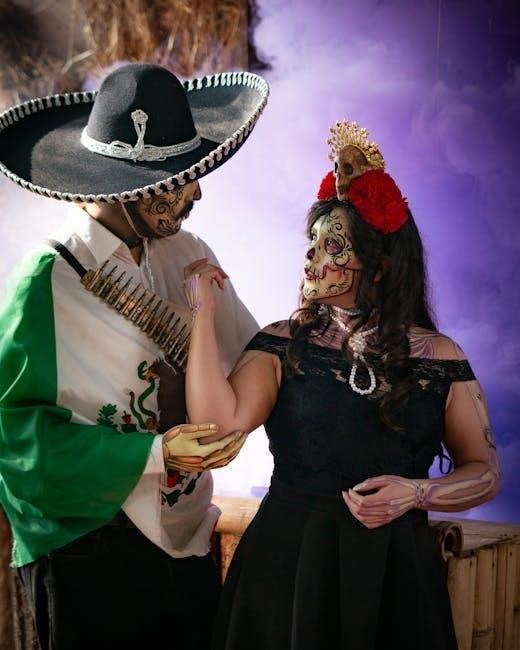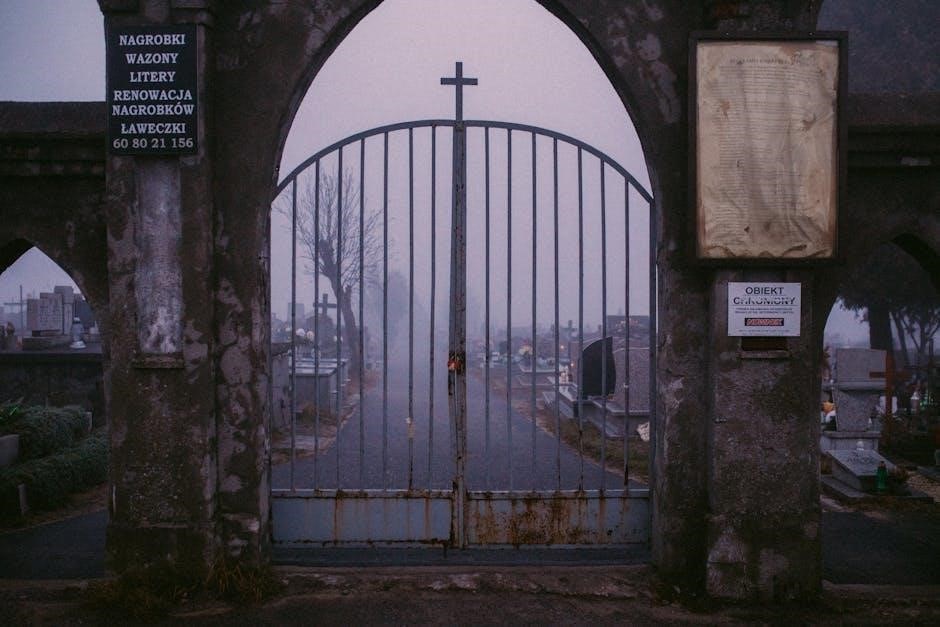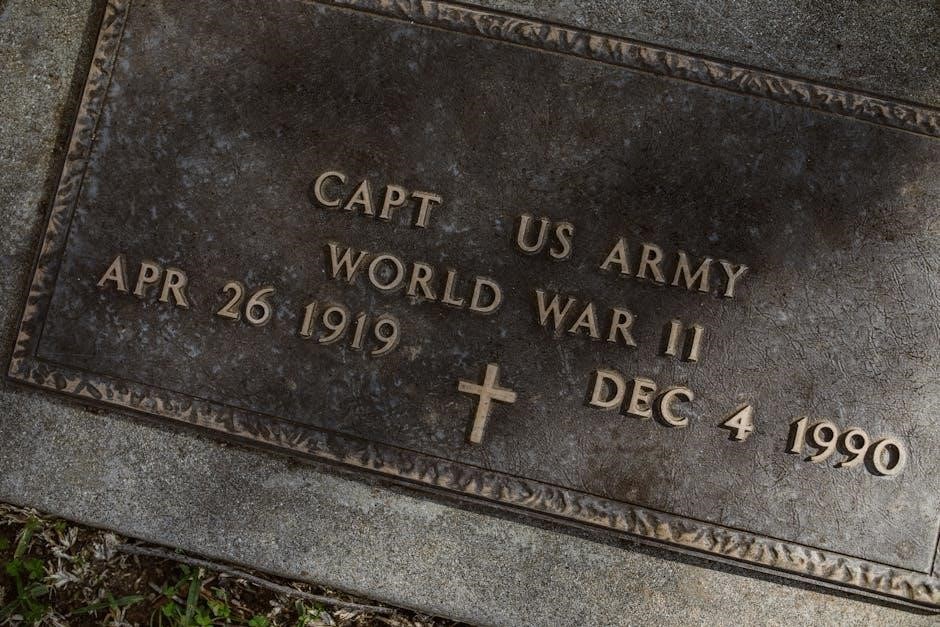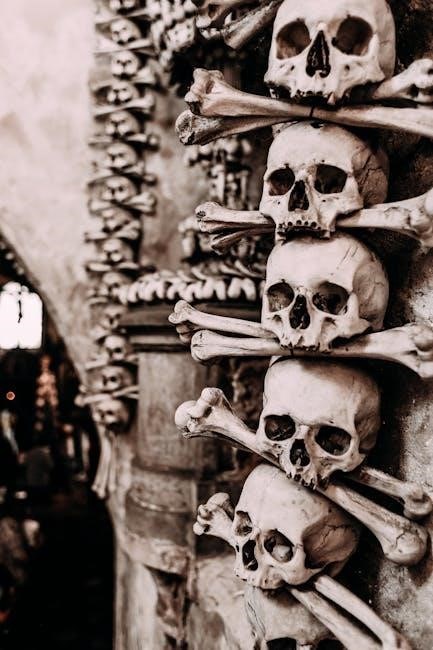A Chronicle of a Death Foretold by Gabriel García Márquez is a gripping tale of fate‚ honor‚ and tragedy‚ blending journalism with fiction to explore moral complexities.
Overview of the Novel
A Chronicle of a Death Foretold revolves around the tragic murder of Santiago Nasar‚ unfolding through a non-linear narrative that blends journalistic inquiry with fictional storytelling. The novel meticulously reconstructs events leading to Santiago’s death‚ orchestrated by twin brothers seeking to restore their family’s honor. Rich in cultural and symbolic depth‚ it explores themes of fate‚ societal norms‚ and personal responsibility‚ set against the backdrop of a small Colombian town. García Márquez’s masterful storytelling weaves together fragmented memories‚ creating a haunting tale of inevitability and moral complexity.
Significance of the Title
The title A Chronicle of a Death Foretold highlights the inevitability and preordained nature of Santiago Nasar’s murder. It underscores the idea that fate is inescapable‚ with events unfolding as if predetermined. The term “chronicle” suggests a formal‚ almost journalistic account‚ emphasizing the narrative’s detached yet detailed reconstruction of the tragedy. This duality between fate and human agency is central to the novel’s exploration of destiny‚ societal expectations‚ and individual responsibility‚ making the title a profound reflection of the story’s themes and structure.
Themes and Motifs
A Chronicle of a Death Foretold explores themes of fate‚ honor‚ love‚ and revenge‚ intertwined with motifs of death and memory. The novel delves into the inevitability of destiny‚ as Santiago Nasar’s murder is foretold yet unstoppable. Honor emerges as a destructive force‚ driving the twin brothers to avenge Angela Vicario’s shame. Love is portrayed as unattainable and tragic‚ while revenge becomes a relentless pursuit. Memory plays a crucial role‚ as the narrator reconstructs events‚ highlighting the community’s complicity and moral ambiguity. These themes are enriched by symbolic elements like the knife and yellow butterflies‚ underscoring the novel’s profound exploration of human nature and societal norms.

Author Background
Gabriel García Márquez‚ a Nobel Prize-winning Colombian writer‚ is renowned for his magical realism. His works blend fantasy and reality‚ exploring themes of love‚ death‚ and fate‚ deeply rooted in Colombian culture.
Gabriel García Márquez: A Brief Biography
Gabriel García Márquez was born on March 6‚ 1927‚ in Aracataca‚ Colombia. He began his career as a journalist and later became a celebrated novelist and short-story writer. His unique style‚ known as magical realism‚ blends realistic descriptions of everyday life with magical and fantastical elements. This distinctive approach has made him one of the most influential writers of the 20th century. García Márquez’s works‚ such as A Chronicle of a Death Foretold and One Hundred Years of Solitude‚ have earned him the Nobel Prize in Literature in 1982. His writing often explores themes of love‚ family‚ history‚ and the complexities of human nature‚ drawing heavily from his Colombian heritage. García Márquez passed away on April 17‚ 2014‚ leaving behind a legacy of literary masterpieces that continue to captivate readers worldwide. His ability to weave intricate narratives and create vivid characters has solidified his place as a literary icon‚ and his contributions to world literature remain unparalleled. His work continues to be studied and admired‚ offering insights into the human condition and the rich cultural tapestry of Colombia. Through his writing‚ García Márquez has left an indelible mark on modern literature‚ ensuring his stories and ideas will endure for generations to come. His influence extends beyond literature‚ shaping the way people perceive and interpret the world around them. García Márquez’s life and work serve as a testament to the power of storytelling and the enduring impact of great literature.
Major Works and Contributions to Literature
Gabriel García Márquez is renowned for his groundbreaking novels and short stories that have redefined world literature. His most celebrated works include One Hundred Years of Solitude‚ Love in the Time of Cholera‚ and A Chronicle of a Death Foretold. These works showcase his unique style of magical realism‚ blending the fantastical with the real. His contributions to literature are marked by his ability to craft compelling narratives that explore themes of love‚ family‚ history‚ and the human condition. García Márquez’s writing has left an indelible mark on modern literature‚ earning him the Nobel Prize in Literature in 1982. His works continue to be widely read and studied‚ cementing his legacy as one of the greatest writers of the 20th century.
Style and Narrative Technique
Gabriel García Márquez’s unique style in A Chronicle of a Death Foretold combines magical realism with a journalistic tone‚ creating a captivating blend of fact and fiction. The novel employs a non-linear narrative structure‚ weaving past and present to build suspense and explore themes of fate and morality. The use of an unreliable narrator adds complexity‚ as multiple perspectives blur the line between truth and memory. This distinctive approach enhances the novel’s emotional depth‚ immersing readers in the tragic events unfolding in a small Colombian town‚ while showcasing García Márquez’s mastery of storytelling.

Plot Summary
A Chronicle of a Death Foretold recounts the tragic events surrounding Santiago Nasar’s murder‚ beginning with a wedding and a prophecy‚ leading to his inevitable death and the town’s haunting aftermath.
The Wedding and the Prophecy
The novella opens with the wedding of Angela Vicario and Bayardo San Román‚ which is overshadowed by a ominous prophecy. The townspeople are aware of the impending doom that awaits Santiago Nasar‚ the groom’s friend‚ who is destined to die at the hands of Angela’s brothers. This prophecy sets the tone for the unfolding tragedy‚ intertwining fate‚ honor‚ and the unyielding cultural norms of the community. The events that transpire are both shocking and inevitable‚ leaving a lasting impact on all involved.
The Murder of Santiago Nasar
The murder of Santiago Nasar is a pivotal event in the novella‚ carried out by Angela Vicario’s twin brothers to restore their family’s honor. The act is brutal and public‚ with Santiago being stabbed repeatedly in a ritualistic manner. Despite warnings and omens‚ the killing unfolds with a sense of inevitability‚ reflecting the rigid cultural norms and the community’s complicity in the tragedy. The brothers’ actions are driven by a misguided sense of duty‚ while Santiago’s fate is sealed by a combination of fate and societal expectations.
The Aftermath and Community Reaction
Following Santiago Nasar’s murder‚ the community reacts with a mix of shock and resignation‚ as if the tragedy was inevitable. The aftermath reveals deep-seated cultural norms‚ where honor and shame dictate societal behavior. Angela Vicario‚ despite her role in the events‚ gains a form of twisted respect‚ while the twin brothers face minimal consequences. The narrator’s investigation years later exposes the collective guilt and complicity‚ highlighting how the town’s silence and acceptance perpetuated the cycle of violence and moral ambiguity.

Themes
Fate‚ honor‚ love‚ revenge‚ memory‚ and societal norms are central themes‚ interwoven to explore human complexity and moral ambiguity in a rigid cultural framework.
Fate and Destiny
Fate and destiny are central to the novella‚ as Santiago Nasar’s murder is foretold yet inescapable. The narrator’s shifting perspectives highlight the inevitability of events‚ blending journalism with fiction. Cultural norms and divine signs‚ like the yellow butterflies‚ underscore fate’s role. The townspeople’s awareness yet inaction reveal a collective resignation to destiny. Marquéz masterfully explores how fate intertwines with human agency‚ creating a tragic yet mesmerizing narrative. The novella’s structure emphasizes the inexorable march toward Santiago’s death‚ leaving readers questioning free will and predetermination.
Honor and Shame
Honor and shame drive the novella’s tragic events‚ as the Vicario brothers avenge their family’s honor after Angela’s public jilting. The cultural imperative of restoring honor through violence is deeply rooted in the Colombian setting. Santiago Nasar’s fate is sealed when Angela names him as the man who dishonored her. The townspeople‚ aware of the impending murder‚ remain passive‚ highlighting the societal acceptance of such brutal codes. Marquéz critiques the toxic machismo and rigid moral norms that perpetuate cycles of violence and shame‚ emphasizing the devastating consequences of upholding honor at any cost.
Love and Revenge
Love and revenge intertwine tragically in the novella‚ as Angela Vicario’s rejection by Santiago Nasar sparks a chain of events. Her loveless marriage to Bayardo San Román and subsequent betrayal fuel her desire for revenge. The twins’ brutal avenging of their family’s honor reflects the destructive power of revenge in a society governed by rigid moral codes. Marquéz portrays love as unattainable and revenge as inevitable‚ highlighting the devastating consequences of both. This duality underscores the novel’s exploration of human emotion and societal constraints.
Memory and Remorse
Memory and remorse are central themes‚ as the narrator reconstructs Santiago Nasar’s murder years later. The town’s collective memory of the event reveals a shared guilt‚ while Angela Vicario’s memories of her lost love and betrayal haunt her. The Vicario family’s remorse over their role in the tragedy underscores the enduring impact of unchecked emotions. Marquéz uses memory to explore how remorse shapes individual and communal identities‚ leaving a lasting scar on those involved. The novel highlights how the past lingers‚ refusing to be forgotten.

Narrative Structure
The novel employs a non-linear structure‚ blending journalism with fiction‚ and features an unreliable narrator whose complex perspective shapes the storytelling and exploration of truth.
Non-Linear Storytelling
Gabriel García Márquez employs a non-linear narrative structure in A Chronicle of a Death Foretold‚ disrupting the traditional chronological order of events. The story begins with Santiago Nasar’s murder and then unravels the events leading to his death through fragmented flashbacks and multiple perspectives. This technique mirrors the cyclical nature of fate‚ emphasizing the inevitability of the tragedy. By interweaving past and present‚ the novel creates a layered exploration of causality‚ moral complexity‚ and the collective guilt of the community‚ drawing readers into its haunting and reflective rhythm.
Unreliable Narrator
The narrator in A Chronicle of a Death Foretold is a complex‚ often unreliable figure whose shifting perspectives and incomplete knowledge obscure the truth. By alternating between first and third-person narratives‚ the author blurs the line between objectivity and personal bias. This unreliability reflects the fragmented nature of memory and the subjective interpretation of events‚ underscoring the ambiguity of moral responsibility and the collective complicity in Santiago Nasar’s fate. The narrator’s uncertain voice adds depth to the novel’s exploration of human fallibility and societal norms.
Mix of Journalism and Fiction
Gabriel García Márquez masterfully blends journalism with fiction in A Chronicle of a Death Foretold‚ creating a unique narrative style that feels both factual and fictional. The novel’s structure‚ resembling a journalistic investigation‚ draws readers into the tragic events while maintaining literary depth. This fusion allows Márquez to explore themes of fate‚ honor‚ and societal norms through a lens that feels both objective and deeply human‚ making the story resonate as a universal tale of moral complexity and inevitability.

Historical and Cultural Context
A Chronicle of a Death Foretold is set in 20th-century Colombia‚ exploring themes of machismo‚ honor‚ and religious traditions that shape the community’s actions and beliefs.
Setting: Colombia in the 20th Century
A Chronicle of a Death Foretold unfolds in a small Colombian town during the 20th century‚ where rigid social hierarchies and cultural traditions dominate. The setting reflects the blending of old and new‚ with the arrival of the bishop’s boat symbolizing a connection to the wider world. The town’s insular nature amplifies the tragic events‚ as societal expectations and machismo dictate the characters’ actions. This backdrop of rural Colombia mirrors García Márquez’s own upbringing in Aracataca‚ infusing the story with authenticity and cultural depth.
Cultural Values and Machismo
A Chronicle of a Death Foretold delves into the rigid cultural values of Colombian society‚ particularly the concept of machismo. The novella portrays a world where male honor is paramount‚ and reputation is fiercely protected. The twin brothers’ quest for vengeance exemplifies this‚ driven by the societal imperative to restore family honor. Women‚ too‚ are bound by these norms‚ as seen in Angela Vicario’s role as a symbol of familial honor. This exploration of cultural values highlights the devastating consequences of adhering to rigid social expectations and gender roles.
Religious and Social Norms
A Chronicle of a Death Foretold vividly portrays a society deeply influenced by religious and social norms. The novella reflects a culture where Catholicism shapes moral codes‚ yet contradictions arise in its application. The community’s acceptance of fate aligns with religious fatalism‚ while their complicity in Santiago’s murder reveals a flawed moral structure. These norms govern relationships and behaviors‚ like the Vicario family’s rigid adherence to honor‚ underscoring the tension between religious teachings and societal practices in a morally complex world.

Character Analysis
A Chronicle of a Death Foretold delves into complex characters‚ including Santiago Nasar‚ Angela Vicario‚ and the twin brothers‚ exploring their roles in fate and honor-driven tragedy.
Santiago Nasar: The Victim
Santiago Nasar‚ the central figure‚ is portrayed as a tragic victim of fate and societal expectations. His death is foretold yet inevitable‚ symbolizing the inexorable nature of destiny. The novel explores his final hours‚ revealing his unawareness of the impending danger. Through his character‚ García Márquez critiques the rigid honor codes and gender roles that lead to his demise. Santiago’s actions‚ though flawed‚ highlight the human complexity caught in a web of fate and communal complicity. His death serves as a poignant reflection on justice‚ morality‚ and the inevitability of tragedy.
Angela Vicario: The Jilted Bride
Angela Vicario is the catalyst of the tragedy‚ her actions driven by shame and betrayal. Jilted by Santiago Nasar‚ she names him as the man who dishonored her‚ setting the deadly events in motion. Her decision‚ rooted in societal expectations of honor‚ highlights the oppressive gender norms of her culture. Angela’s character embodies the tension between personal desire and communal judgment‚ making her a tragic figure whose choices forever alter the fate of those around her.
The Twin Brothers: Avengers of Honor
The twin brothers‚ Pedro and Pablo Vicario‚ are driven by a rigid sense of honor and duty. Believing their sister Angela’s reputation has been tarnished‚ they vowed to avenge her shame. Their relentless pursuit of Santiago Nasar‚ despite moral ambiguities‚ underscores the deep-rooted cultural values of their community. The brothers’ actions reflect a tragic adherence to societal expectations‚ making them both executioners and victims of a flawed system of honor and retribution.
The Narrator: A Complex Figure
The narrator in A Chronicle of a Death Foretold is a multifaceted character‚ oscillating between first and third-person perspectives. This duality reflects his deep connection to the events and his attempt to reconstruct the truth; As both a participant and an observer‚ he grapples with the moral and emotional weight of the tragedy. His unreliability stems from his subjective reconstruction of the past‚ questioning the accuracy of memory and the nature of guilt. This complexity mirrors the broader themes of memory and communal responsibility in the novel;

Symbolism
The Knife as a Symbol of Destiny and the recurring Yellow Butterflies represent Santiago Nasar’s inescapable fate and the tragic beauty of his doomed existence in the novel.
The Boat and the Bishop
The boat symbolizes inevitability and fate‚ as Santiago Nasar awaits it to meet the bishop‚ unaware of his impending death. The bishop’s absence‚ despite the townspeople’s anticipation‚ underscores the futility of seeking divine intervention. This motif reflects the novel’s exploration of fate‚ moral responsibility‚ and the intersection of human and divine will. The boat’s arrival and the bishop’s failure to appear encapsulate the tragic inevitability of Santiago’s death‚ highlighting the town’s complicity and the inexorable march of destiny.
The Yellow Butterflies
The yellow butterflies symbolize love‚ passion‚ and doomed fate‚ as they persistently follow Santiago Nasar‚ foreshadowing his tragic end. Their constant presence mirrors the obsessive yet unattainable love Santiago harbors for Ángela Vicario. The butterflies also represent the fleeting nature of life and the inevitability of death‚ as they vanish after Santiago’s murder‚ leaving a haunting memory. This motif weaves together themes of love‚ destiny‚ and the irreversibility of fate‚ deeply embedding the novel’s tragic essence.
The Knife as a Symbol of Destiny
The knife in A Chronicle of a Death Foretold symbolizes Santiago Nasar’s inevitable fate and the instrument of his death. It represents the inexorable force of destiny‚ as the twins meticulously sharpen it‚ embodying their determination to fulfill their perceived duty. The knife also serves as a tool of honor‚ reflecting the cultural values that drive the characters to violence. Its presence throughout the narrative underscores the tragic inevitability of Santiago’s demise‚ making it a potent symbol of fate and societal expectations.

Reception and Legacy
A Chronicle of a Death Foretold received widespread critical acclaim‚ solidifying García Márquez’s literary legacy. Its exploration of fate and honor influenced world literature significantly.
Critical Acclaim and Reviews
A Chronicle of a Death Foretold has garnered widespread critical acclaim for its masterful blend of journalism and fiction. Reviewers praise García Márquez’s ability to weave moral and emotional complexity into a gripping narrative. Angela Carter described it as a “tour de force” and “mesmerizing work” in The Guardian. The novel’s accessible style‚ despite its depth‚ has made it a standout in world literature‚ solidifying its place as a modern classic.
Impact on World Literature
A Chronicle of a Death Foretold has left an indelible mark on world literature‚ influencing countless authors and works. Its unique narrative style and exploration of universal themes like fate and honor have made it a seminal text in magical realism. The novella’s ability to transcend cultural boundaries has contributed to its global acclaim‚ cementing García Márquez’s reputation as a literary giant and earning him the Nobel Prize in Literature in 1982. Its influence continues to resonate in contemporary writing.
Adaptations and Interpretations
A Chronicle of a Death Foretold has been adapted into films‚ plays‚ and operas‚ each offering unique interpretations of the novella’s themes. Its adaptability underscores the universal appeal of García Márquez’s work. Scholars and critics continue to explore its narrative techniques and cultural significance‚ while readers worldwide find personal connections to its exploration of fate and honor. These interpretations highlight the novella’s enduring relevance and its ability to inspire diverse creative and scholarly responses.

Availability and Access
A Chronicle of a Death Foretold is widely available as a PDF‚ with digital editions on platforms like Internet Archive. Free downloads and various translations‚ including those by Gregory Rabassa‚ make it accessible to global readers.
Pdf Versions and Digital Editions
A Chronicle of a Death Foretold is readily available in PDF format‚ with digital editions accessible through platforms like Internet Archive and major e-book retailers. The novella spans approximately 120 pages‚ ensuring a concise yet immersive reading experience. PDF versions often include introductions and forewords‚ enhancing the reader’s understanding of the narrative. Digital editions are compatible with various devices‚ making it easy to read on smartphones‚ tablets‚ or e-readers. This accessibility ensures that García Márquez’s timeless story reaches a global audience effortlessly.
Translations and Editions
A Chronicle of a Death Foretold is available in multiple translations‚ including English‚ French‚ Czech‚ German‚ and Spanish. The novella has been widely published in various editions‚ with Gregory Rabassa’s translation being particularly acclaimed. PDF versions often feature prefaces‚ summaries‚ and analyses‚ enriching the reader’s experience. Editions vary in format‚ from print to digital‚ ensuring accessibility for diverse readers. The novella’s universal themes are preserved across translations‚ making it a beloved work in world literature.
Free Downloads and Resources
A Chronicle of a Death Foretold is widely available as a free PDF download through platforms like Internet Archive and various academic repositories. Many websites offer the novella in digital formats‚ including PDF and EPUB‚ for easy access. Additionally‚ some libraries and educational sites provide free downloads‚ often accompanied by summaries and analysis guides. Readers can also find preview editions and excerpts online‚ making it accessible for those seeking to explore the text before purchasing a physical copy.
A Chronicle of a Death Foretold masterfully explores fate‚ honor‚ and human flaws through Santiago Nasar’s tragic tale‚ blending journalism with fiction to create a timeless classic;
Final Thoughts on the Novel
A Chronicle of a Death Foretold is a masterful exploration of fate‚ honor‚ and human frailty. García Márquez’s unique blend of journalism and fiction creates a haunting narrative that lingers long after the final page. The novel’s non-linear structure and unreliable narrator add layers of complexity‚ while its critique of societal norms and machismo remains poignant. Santiago Nasar’s tragic fate serves as a powerful commentary on destiny and moral responsibility‚ cementing the novel’s place as a timeless literary masterpiece.
Recommendations for Readers
A Chronicle of a Death Foretold is a must-read for fans of literary fiction and magical realism. Its blend of journalism and fiction offers a unique narrative experience. Readers drawn to themes of fate‚ honor‚ and societal norms will find the novel deeply thought-provoking. The concise structure and moral complexity make it accessible yet impactful. For those new to García Márquez‚ this novella is an excellent introduction to his style. It is a haunting‚ unforgettable tale that challenges readers to reflect on human nature and destiny.
